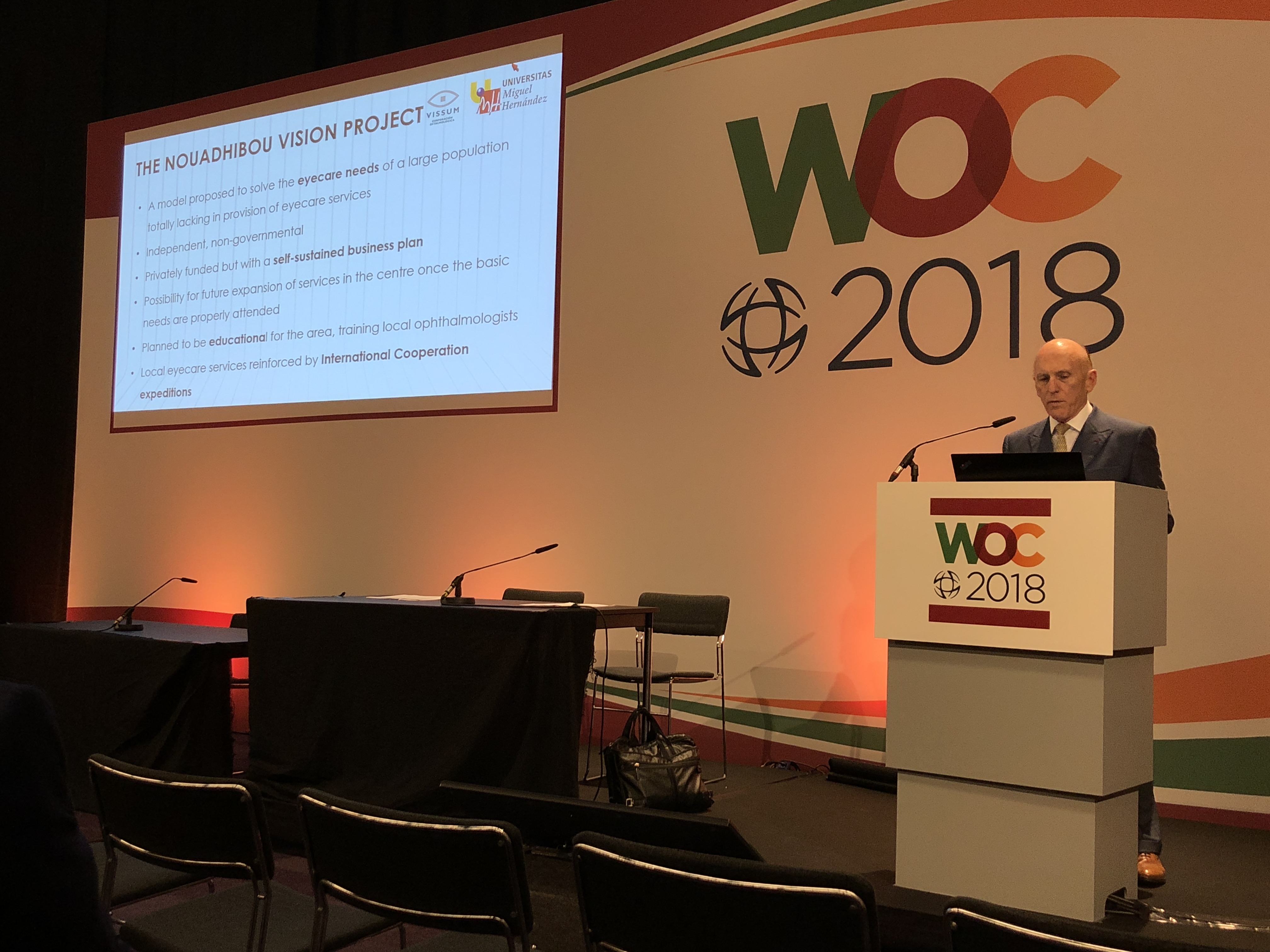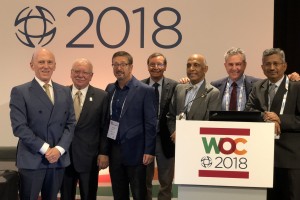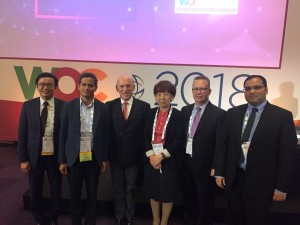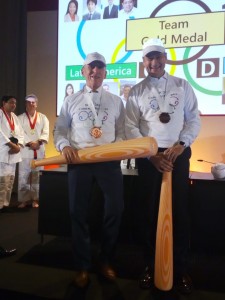
Doctor Jorge Alio participated in 26 talks and panel discussions. At the same time his scientific team gave 57 presentations.
 Dr. Jorge Alio participated in the World Ophthalmology Congress 2018 held in Barcelona from June 16 – 19. He became the most active participant, having taken part in 26 talks, panel discussions and sessions. His scientific team was also the most active, having given 57 presentations.
Dr. Jorge Alio participated in the World Ophthalmology Congress 2018 held in Barcelona from June 16 – 19. He became the most active participant, having taken part in 26 talks, panel discussions and sessions. His scientific team was also the most active, having given 57 presentations.
In addition, Alio has interacted with the best ophthalmologists in the world in order to share and update knowledge on advances and novelties in eye health.
Dr. Jorge Alio, who has been ranked twelfth among the world’s most influential ophthalmologists in the list of 100 professionals, entitled “The Power List 2018” drawn up by the British magazine “The Ophthalmologist”, started his participation in the World Ophthalmology Congress 2018 on June 16th, by giving a presentation entitled “Corneal Stroma Regeneration Surgery”.
On Sunday, June 17th, Jorge Alio, the medical director of Vissum Ophthalmological Corporation, participated in the panel discussion on “Unmet Needs and Translational Opportunities in IOL Technology”, gave a presentation entitled “A Novel Intraocular Open-Capsule Devices for the Prevention of  Posterior Capsule Opacification”, gave the following speeches: “Posterior a Anterior: the Role of Integral Diagnoses in Cataract Refractive Surgery”, “Ocular Surface Syndrome and Corneal Dysesthesia after Lasik: Treatment Innovations”, and actively participated in “Corneal Cataract Surgery Marathon”. Furthermore, Jorge Alio, the academic of the Royal Academy of Medicine of the Valencian Community (RAMCV), had the opportunity to present his project “Vision Nouadhibou”, which is devoted to the construction of the first eye hospital in Mauritania.Moreover, he gave the following presentations: “Surgery of Astigmatism in Normal and Abnormal Corneas with Toric Phakic IOLs”, “Waverfront Correction of the Irregular Cornea: Outco mes and Limitations With the Present Technology” and “The World Burden of Cataract Surgery: The Numbers and the Patients Suffering”
Posterior Capsule Opacification”, gave the following speeches: “Posterior a Anterior: the Role of Integral Diagnoses in Cataract Refractive Surgery”, “Ocular Surface Syndrome and Corneal Dysesthesia after Lasik: Treatment Innovations”, and actively participated in “Corneal Cataract Surgery Marathon”. Furthermore, Jorge Alio, the academic of the Royal Academy of Medicine of the Valencian Community (RAMCV), had the opportunity to present his project “Vision Nouadhibou”, which is devoted to the construction of the first eye hospital in Mauritania.Moreover, he gave the following presentations: “Surgery of Astigmatism in Normal and Abnormal Corneas with Toric Phakic IOLs”, “Waverfront Correction of the Irregular Cornea: Outco mes and Limitations With the Present Technology” and “The World Burden of Cataract Surgery: The Numbers and the Patients Suffering”
 On June 18th Jorge Alio, the creator of the concept of microincisional cataract surgery (MICS) and pioneer in multifocal, toric, phakic and accommodative IOLs, shared his point of view regarding phakic intraocular lenses and offered the conference entitled “Defocus Curve Function and Contrast Sensitivity with the Different IOL Multifocal Technologies”. In addition, he had the opportunity to interact with other ophthalmology professionals and discuss topics such as ”The Next Technological Revolution in Refractive Surgery”, ”Current Ways of Keratoconus and Ectasia Treatment: from the Reticulation to the Keratoplasty“ and “LASIK for High Myopia: Where and Why are the Limits?”. Moreover, Dr. Alio gave a presentation entitled “Ocular Optical Quality after Small Incision Lenticule Extraction Surgery (SMILE) to Correct Myopia”.
On June 18th Jorge Alio, the creator of the concept of microincisional cataract surgery (MICS) and pioneer in multifocal, toric, phakic and accommodative IOLs, shared his point of view regarding phakic intraocular lenses and offered the conference entitled “Defocus Curve Function and Contrast Sensitivity with the Different IOL Multifocal Technologies”. In addition, he had the opportunity to interact with other ophthalmology professionals and discuss topics such as ”The Next Technological Revolution in Refractive Surgery”, ”Current Ways of Keratoconus and Ectasia Treatment: from the Reticulation to the Keratoplasty“ and “LASIK for High Myopia: Where and Why are the Limits?”. Moreover, Dr. Alio gave a presentation entitled “Ocular Optical Quality after Small Incision Lenticule Extraction Surgery (SMILE) to Correct Myopia”.
Finally, on June 19th Jorge Alio finished his participation in the World Ophthalmology Congress 2018, having participated in the panel discussion “Can We Improve Our Results in Cataract Surgery?” and “Visual Outcome in Patients Undergoing LASIK and SMILE”. He also gave two speeches entitled “How long can Phakic IOL Remain in the Eye? Limitations of the anatomy” and “The Preliminary Results of the Phase III Study of a New Accommodative Iintraocular Lens”. In addition, he gave a presentation “What Tools Would We Use for Cataract Surgery in Areas of Limited Resources?” and participated in the session “The Effectiveness of Case-Based Learning in Professional Health Education’.
It should be reminded that Jorge Alio has recently published an article “Cellular Therapy of the Corneal Stroma: Real Approach or Science Fiction?” in the prestigious journal “Ophthalmology Times Europe”. The article is devoted to the research, carried out by the doctor and his collaborators, into extraocular mesenchymal stem cells, which could be an alternative to the classical cornea transplantation.
